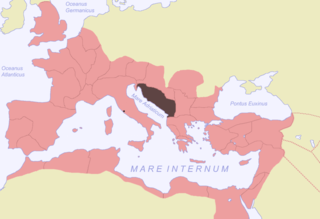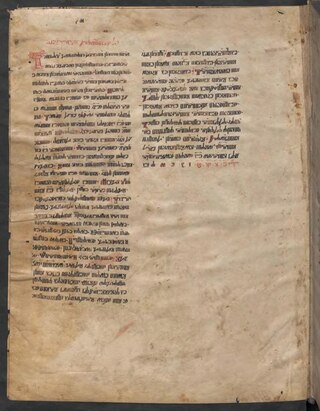
The Glagolitic script is the oldest known Slavic alphabet. It is generally agreed that it was created in the 9th century for the purpose of translating liturgical texts into Old Church Slavonic by Saint Cyril, a monk from Thessalonica. He and his brother Saint Methodius were sent by the Byzantine Emperor Michael III in 863 to Great Moravia to spread Christianity there. After the deaths of Cyril and Methodius, their disciples were expelled and they moved to the First Bulgarian Empire instead. The Early Cyrillic alphabet, which developed gradually in the Preslav Literary School by Greek alphabet scribes who incorporated some Glagolitic letters, gradually replaced Glagolitic in that region. Glagolitic remained in use alongside Latin in the Kingdom of Croatia and alongside Cyrillic until the 14th century in the Second Bulgarian Empire and the Serbian Empire, and later mainly for cryptographic purposes.

The coat of arms of the Republic of Croatia consists of one main shield and five smaller shields which form a crown over the main shield. The main coat of arms is a checkerboard (chequy) that consists of 13 red and 12 white fields. It is also informally known in Croatian as šahovnica. The five smaller shields represent five different historical regions within Croatia.

Sirmium was a city in the Roman province of Pannonia, located on the Sava river, on the site of modern Sremska Mitrovica in the Vojvodina autonomous province of Serbia. First mentioned in the 4th century BC and originally inhabited by Illyrians and Celts, it was conquered by the Romans in the 1st century BC and subsequently became the capital of the Roman province of Pannonia Inferior. In 294 AD, Sirmium was proclaimed one of four capitals of the Roman Empire. It was also the capital of the Praetorian prefecture of Illyricum and of Pannonia Secunda. The site is protected as an archaeological Site of Exceptional Importance. The modern region of Syrmia was named after the city.
Ban was the title of local rulers or officeholders, similar to viceroy, used in several states in Central and Southeastern Europe between the 7th and 20th centuries. The most common examples have been found in medieval Croatia and medieval regions ruled and influenced by the Kingdom of Hungary. They often ruled as the king's governmental representatives, supreme military commanders and judges, and in 18th century Croatia, even as chief government officials. In the Banate of Bosnia they were always de facto supreme rulers.

Illyricum was a Roman province that existed from 27 BC to sometime during the reign of Vespasian. The province comprised Illyria/Dalmatia in the south and Pannonia in the north. Illyria included the area along the east coast of the Adriatic Sea and its inland mountains, eventually being named Dalmatia. Pannonia included the northern plains that now are a part of Serbia, Croatia and Hungary. The area roughly corresponded to part or all of the territories of today's Albania, Kosovo, Montenegro, Serbia, Bosnia and Herzegovina, Croatia, and Slovenia.

Hrvoje Vukčić Hrvatinić was a medieval Bosnian nobleman and magnate, Grand Duke of Bosnia, Knez of Donji Kraji, and Duke of Split. He was the most prominent member of the Hrvatinić noble family, and one of the major feudal lords in Kingdom of Bosnia. He was Grand Duke of Bosnia under three Bosnian kings: King Tvrtko I, King Stephen Dabiša and King Stephen Ostoja. In 1403, and after Tvrtko I's death, Ladislaus of Naples named him his deputy for Dalmatia, and bestowed him with a title Duke of Split, later Herzog of Split. He played a crucial role in the dynastic struggles between the Anjou and Luxembourg claimants to the Hungarian-Croatian throne at the end of the 14th century, as well as in the emergence of the Bosnian Kingdom as a regional power during the same period.

The Bosut is a river in the Syrmia region of eastern Croatia and northwestern Serbia. It is a 186 km long, slow and meandering left tributary of the Sava river.

Ratko Perić is a prelate of the Catholic Church who served as the bishop of Mostar-Duvno and apostolic administrator of Trebinje-Mrkan from 1993 until his retirement in 2020. After his retirement in July 2020, he briefly served as the apostolic administrator of both dioceses until the instalment of his successor Petar Palić in September 2020.

Burnum, an archaeological site, was a Roman Legion camp and town. It is located 2.5 km north of Kistanje, in inland Dalmatia, Croatia. The remains include a praetorium, the foundations of several rooms, the amphitheatre and the aqueduct.
Salvia was an Illyrian settlement in the region of Liburnia of the Illyrian tribe of Delmatae. The exact location is unknown, it is mentioned together with Stridon, possibly at Bosansko Grahovo.

Slabinja is a village in the Sisak-Moslavina County in the central part of Croatia. It is in the Una Valley near the border with Bosnia and Herzegovina, 12.6 kilometres (7.8 mi) southeast of the town of Hrvatska Kostajnica, 9.7 kilometres (6 mi) northwest of the village of Hrvatska Dubica, and 106 kilometres (66 mi) southeast of Croatian capital Zagreb, at the south fringe of the Banovina region. Slabinja is a dormitory village with a resident population of just over 250 people.

Missal of duke Novak was a 14th-century Glagolitic missal. The letters of the missal were later used for the first Croatian printed book Missale Romanum Glagolitice.
Ivan Krstitelj Tkalčić was a Croatian historian, Catholic priest, and prebendary.

St. John's Fortress is an early modern fortress in Šibenik, Croatia, situated atop a hill north of the city's historical center. Named after a medieval church dedicated to St. John the Baptist that had stood there from at least 1444, the fortress, together with the adjacent Barone Fortress, was built during the Cretan War and successfully repelled consecutive Ottoman attacks in 1646 and 1647. A local name for the fortress, Tanaja, comes from one of its structures, a plier-shaped outwork, or tenaille.

Paškal Buconjić was Herzegovinian Croat Franciscan and a prelate of the Catholic Church who served as the first bishop of Mostar-Duvno from 1881 to 1910, as the apostolic administrator of Trebinje-Mrkan from 1890 to 1910, as the apostolic vicar of Herzegovina from 1880 to 1881, and as custos of the Franciscan Custody of Herzegovina between 1874 and 1879.

Branka Raunig was a Bosnian archaeologist, prehistorian and museum curator.
Illyrology or Illyrian studies is interdisciplinary academic field which focuses on scientific study of Illyria and Illyrians as a regional and thematic branch of the larger disciplines of ancient history and archaeology. A practitioner of the discipline is called Illyrologist. His duty is to investigate the range of ancient Illyrian history, culture, art, language, heraldry, numizmatic, mythology, economics, ethics, etc. from c. 1000 BC up to the end of Roman rule around the 5th century.

Nada Miletić was a Bosnian medievalist, art historian and archaeologist, who was a scientific expert at the National Museum of Bosnia and Herzegovina and founded the study of the Migration Period in Bosnian archaeology.















